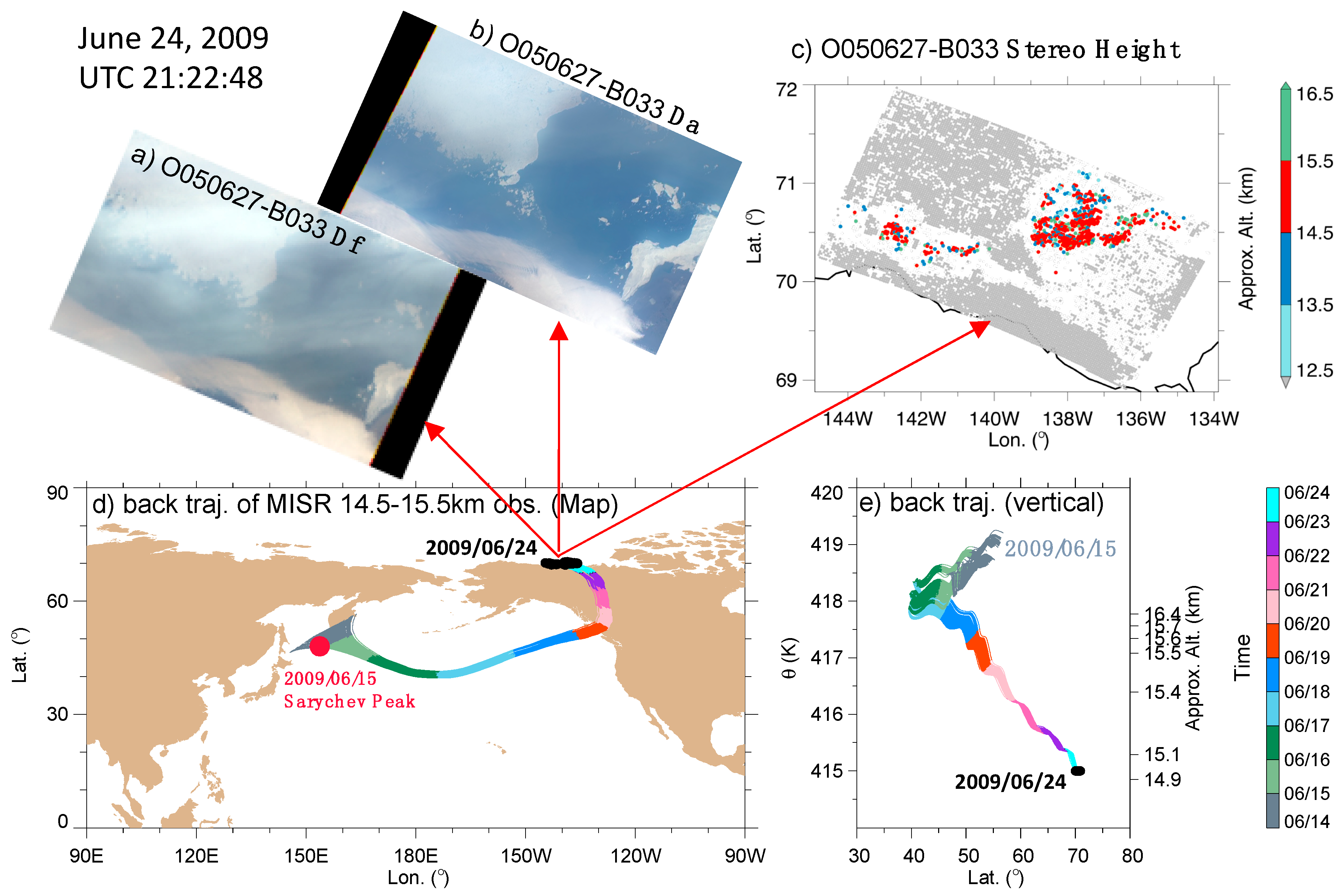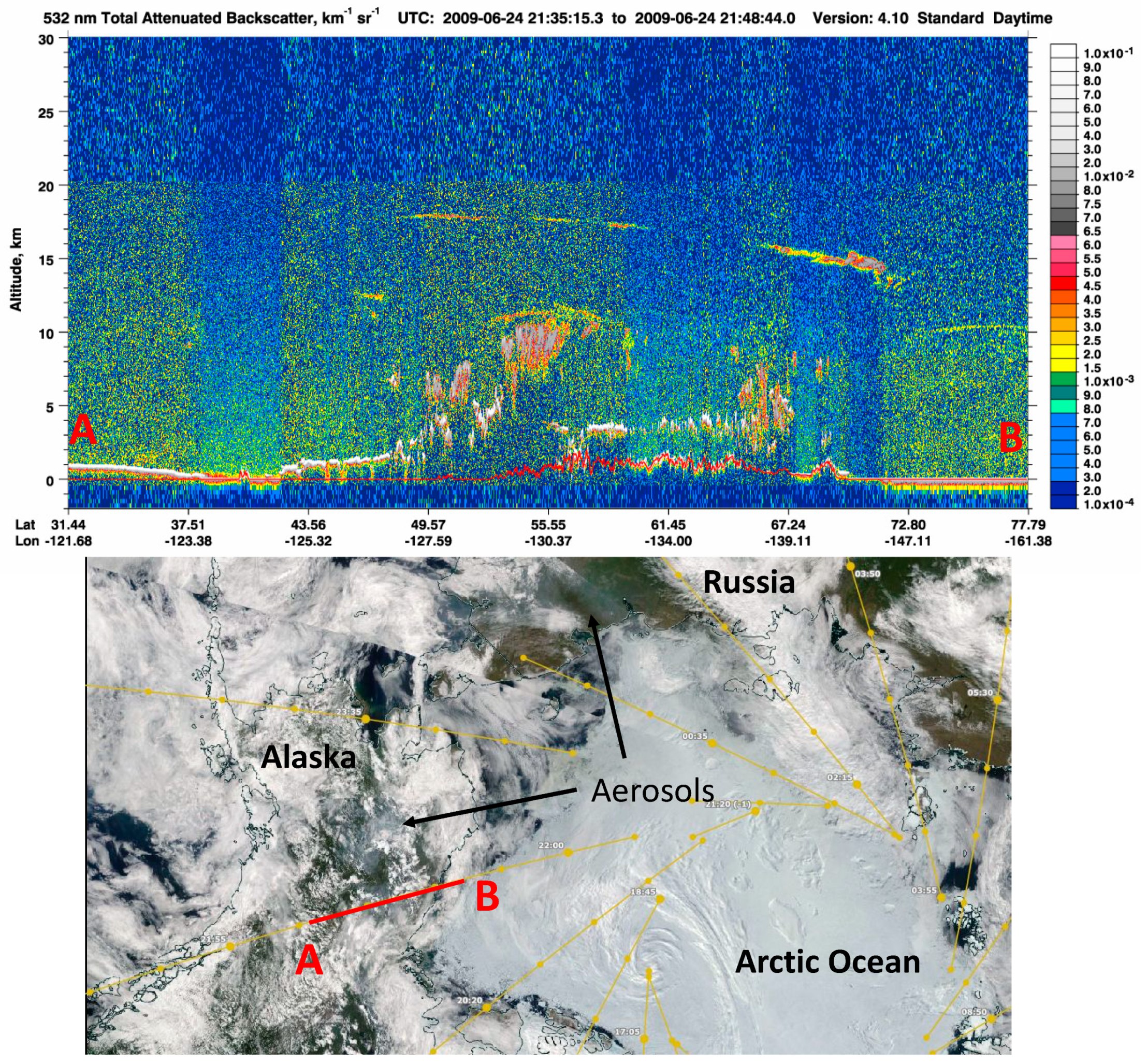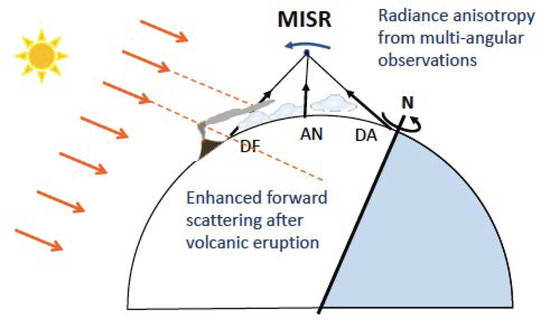MISR Radiance Anomalies Induced by Stratospheric Volcanic Aerosols
Abstract
:1. Introduction
2. Multi-Angular Views of Volcanic Plumes and Aerosols
2.1. The Sarychev Eruption, June 2009
2.2. Stratospheric Aerosols from the Sarychev Eruption
3. Anisotropy of MISR Monthly Radiances
3.1. MISR Monthly Mean Radiances
3.2. SO2 Observations of High-Injection Volcanic Eruptions
3.3. MISR Radiance Anomalies Induced by Volcano Eruptions
4. Discussion
4.1. Effects of Volcanic Injection Height
4.2. Implication for Shortwave Radiation
4.3. Roles of Stratospheric Water and Transport
5. Conclusions
Author Contributions
Funding
Acknowledgments
Conflicts of Interest
References
- Hansen, J.; Lacis, A.; Ruedy, R.; Sato, M. Potential climate impact of Mount Pinatubo eruption. Geophys. Res. Lett. 1992, 19, 215–218. [Google Scholar] [CrossRef]
- Robock, A.; Mao, J. The volcanic signal in surface temperature observations. J. Clim. 1995, 8, 1086–1103. [Google Scholar] [CrossRef]
- Minnis, P.; Harrison, E.F.; Stowe, L.L.; Gibson, G.G.; Denn, F.M.; Doelling, D.R.; Smith, W.L., Jr. Radiative climate forcing by the Mount Pinatubo eruption. Science 1993, 259, 1411–1415. [Google Scholar] [CrossRef] [PubMed]
- Solomon, S.; Daniel, J.S.; Neely, R.R., III; Vernier, J.P.; Dutton, E.G.; Thomason, L.W. The persistently variable “background” stratospheric aerosol layer and global climate change. Science 2011, 333, 866–870. [Google Scholar] [CrossRef] [PubMed]
- Lohmann, U.; Karcher, B.; Timmreck, C. Impact of the Mount Pinatubo eruption on cirrus clouds formed by homogeneous freezing in the ECHAM4 GCM. J. Geophys. Res. 2003, 108, 4568. [Google Scholar] [CrossRef]
- Campbell, J.R.; Welton, E.J.; Krotkov, N.A.; Yang, K.; Stewart, S.A.; Fromm, M.D. Likely seeding of cirrus clouds by stratospheric Kasatochi volcanic aerosol particles near a mid-latitude tropopause fold. Atmos. Environ. 2012, 46, 441–448. [Google Scholar] [CrossRef]
- Solomon, S.; Sanders, R.W.; Garcia, R.R.; Keys, J.G. Enhanced chlorine dioxide and ozone depletion in Antarctica due to volcanic aerosols. Nature 1993, 363, 245–248. [Google Scholar] [CrossRef]
- Thomason, L.W. A diagnostic stratospheric aerosol size distribution inferred from SAGE II measurements. J. Geophys. Res. 1991, 96, 22501–22508. [Google Scholar] [CrossRef]
- Lumpe, J.D.; Bevilacqua, R.M.; Hoppel, K.W.; Krigman, S.S.; Kriebel, D.L.; Debrestian, D.J.; Randall, C.E.; Rusch, D.W.; Brogniez, C.; Ramananahérisoa, R.; et al. POAM II retrieval algorithm and error analysis. J. Geophys. Res. 1997, 102, 23593–23614. [Google Scholar] [CrossRef] [Green Version]
- Burton, S.P.; Thomason, L.W.; Sasano, Y.; Hayashida, S. Comparison of Aerosol Extinction Measurements by ILAS and SAGE II. Geophys. Res. Lett. 1999, 26, 1719–1722. [Google Scholar] [CrossRef]
- Thomason, L.W. Toward a combined SAGE II-HALOE aerosol climatology: An evaluation of HALOE version 19 stratospheric aerosol extinction coefficient observations. Atmos. Chem. Phys. 2012, 12, 8177–8188. [Google Scholar] [CrossRef] [Green Version]
- Vanhellemont, F.; Fussen, D.; Mateshvili, N.; Tétard, C.; Bingen, C.; Dekemper, E.; Loodts, N.; Kyrölä, E.; Sofieva, V.; Tamminen, J.; et al. Optical extinction by upper tropospheric/stratospheric aerosols and clouds: GOMOS observations for the period 2002–2008. Atmos. Chem. Phys. 2010, 10, 7997–8009. [Google Scholar] [CrossRef] [Green Version]
- Bourassa, A.E.; Degenstein, D.A.; Gattinger, R.L.; Llewellyn, E.J. Stratospheric aerosol retrieval with optical spectrograph and infrared imaging system limb scatter measurements. J. Geophys. Res. 2007, 112, D10217. [Google Scholar] [CrossRef]
- Ovigneur, B.; Landgraf, J.; Snel, R.; Aben, I. Retrieval of stratospheric aerosol density profiles from SCIAMACHY limb radiance measurements in the O2 A-band. Atmos. Meas. Tech. 2011, 4, 2359–2373. [Google Scholar] [CrossRef]
- Taha, G.; Rault, D.F.; Loughman, R.P.; Bourassa, A.E.; Savigny, C.V. SCIAMACHY stratospheric aerosol extinction profile retrieval using the OMPS/LP algorithm. Atmos. Meas. Tech. 2011, 4, 547–556. [Google Scholar] [CrossRef] [Green Version]
- Von Savigny, C.; Ernst, F.; Rozanov, A.; Hommel, R.; Eichmann, K.-U.; Rozanov, V.; Burrows, J.P.; Thomason, L.W. Improved stratospheric aerosol extinction profiles from sciamachy: Validation and sample results. Atmos. Meas. Tech. Discuss. 2015, 8, 8353–8383. [Google Scholar] [CrossRef]
- Lambert, A.L.; Grainger, R.G.; Remedios, J.J.; Rodgers, C.D.; Corney, M.A.; Taylor, F.W. Measurements of the evolution of the Mount Pinatubo aerosol clouds by ISAMS. Geophys. Res. Lett. 1993, 20, 1287–1290. [Google Scholar] [CrossRef]
- Massie, S.T.; Gille, J.C.; Edwards, D.P.; Bailey, P.L.; Lyjak, L.V.; Craig, C.A.; Cavanaugh, C.P.; Mergenthaler, J.L.; Roche, A.E.; Kumer, J.B.; et al. Validation studies using multiwavelength Cryogenic Limb Array Etalon Spectrometer (CLAES) observations of stratospheric aerosols. J. Geophys. Res. 1996, 101, 9757–9773. [Google Scholar] [CrossRef]
- Thomason, L.W.; Ernest, N.; Millán, L.; Rieger, L.; Bourassa, A.; Vernier, J.P.; Manney, G.; Luo, B.; Arfeuille, F.; Peter, T. A global space-based stratospheric aerosol climatology: 1979–2016. Earth Syst. Sci. Data 2018, 10, 469–492. [Google Scholar] [CrossRef] [Green Version]
- Osborn, M.T.; Kent, G.S.; Trepte, C.R. Stratospheric aerosol measurements by the Lidar in Space Technology Experiment. J. Geophys. Res. 1998, 103, 11447–11453. [Google Scholar] [CrossRef] [Green Version]
- Vernier, J.P.; Pommereau, J.P.; Garnier, A.; Pelon, J.; Larsen, N.; Nielsen, J.; Christensen, T.; Cairo, F.; Thomason, L.W.; Leblanc, T.; et al. Tropical stratospheric aerosol layer from CALIPSO lidar observations. J. Geophys. Res. 2009, 114, D00H10. [Google Scholar] [CrossRef]
- Vernier, J.P.; Fairlie, T.D.; Deshler, T.; Natarajan, M.; Knepp, T.; Foster, K.; Wienhold, F.G.; Bedka, K.M.; Thomason, L.; Trepte, C. In situ and space-based observations of the Kelud volcanic plume: The persistence of ash in the lower stratosphere. J. Geophys. Res. Atmos. 2016, 121, 11104–11118. [Google Scholar] [CrossRef] [PubMed]
- O’Neill, N.T.; Perro, C.; Saha, A.; Lesins, G.; Duck, T.J.; Eloranta, E.W.; Nott, G.J.; Hoffman, A.; Karumudi, M.L.; Ritter, C.; et al. Properties of Sarychev sulphate aerosols over the Arctic. J. Geophys. Res. 2012, 117, D04203. [Google Scholar] [CrossRef]
- Clarisse, L.; Prata, F. Chapter 11—Infrared Sounding of Volcanic Ash. In Volcanic Ash; Mackie, S., Cashman, K., Ricketts, H., Rust, A., Watson, M., Eds.; Elsevier: Amsterdam, The Netherlands, 2016; pp. 189–215. ISBN 9780081004050. [Google Scholar]
- Carn, S.A.; Krotkov, N.A. Chapter 12—Ultraviolet Satellite Measurements of Volcanic Ash. In Volcanic Ash; Mackie, S., Cashman, K., Ricketts, H., Rust, A., Watson, M., Eds.; Elsevier: Amsterdam, The Netherlands, 2016; pp. 217–231. ISBN 9780081004050. [Google Scholar]
- Guermazi, H.; Sellitto, P.; Serbaji, M.M.; Legras, B.; Rekhiss, F. Assessment of the Combined Sensitivity of Nadir TIR Satellite Observations to Volcanic SO2 and Sulphate Aerosols after a Moderate Stratospheric Eruption. Geosciences 2017, 7, 84. [Google Scholar] [CrossRef]
- Scollo, S.; Kahn, R.A.; Nelson, D.L.; Coltelli, M.; Diner, D.J.; Garay, M.J.; Realmuto, V.J. MISR observations of Etna volcanic plumes. J. Geophys. Res. 2012, 117, D06210. [Google Scholar] [CrossRef]
- Flower, V.J.; Kahn, R.A. Karymsky volcano eruptive plume properties based on MISR multi-angle imagery and the volcanological implications. Atmos. Chem. Phys. 2018, 18, 3903–3918. [Google Scholar] [CrossRef] [PubMed] [Green Version]
- Diner, D.J.; Beckert, J.C.; Reilly, T.H.; Bruegge, C.J.; Conel, J.E.; Kahn, R.A.; Martonchik, J.V.; Ackerman, T.P.; Davies, R.; Gerstl, S.A.; et al. Multi-angle Imaging SpectroRadiometer (MISR) instrument description and experiment overview. IEEE Trans. Geosci. Remote Sens. 1998, 36, 1072–1087. [Google Scholar] [CrossRef]
- Davies, R.; Jovanovic, V.M.; Moroney, C.M. Cloud heights measured by MISR from 2000 to 2015. J. Geophys. Res. Atmos. 2017, 122, 3975–3986. [Google Scholar] [CrossRef]
- Winker, D.M.; Vaughan, M.A.; Omar, A.; Hu, Y.; Powell, K.A.; Liu, Z.; Hunt, W.H.; Young, S.A. Overview of the CALIPSO mission and CALIOP data processing algorithms. J. Atmos. Oceanic Technol. 2009, 26, 2310–2323. [Google Scholar] [CrossRef]
- Jaross, G.; Bhartia, P.K.; Chen, G.; Kowitt, M.; Haken, M.; Chen, Z.; Xu, P.; Warner, J.; Kelly, T. OMPS Limb Profiler instrument performance assessment. J. Geophys. Res. Atmos. 2014, 119. [Google Scholar] [CrossRef]
- Levy, R.C.; Mattoo, S.; Munchak, L.A.; Remer, L.A.; Sayer, A.M.; Patadia, F.; Hsu, N.C. The Collection 6 MODIS aerosol products over land and ocean. Atmos. Meas. Tech. 2013, 6, 2989–3034. [Google Scholar] [CrossRef] [Green Version]
- Gelaro, R.; McCarty, W.; Suárez, M.J.; Todling, R.; Molod, A.; Takacs, L.; Randles, C.A.; Darmenov, A.; Bosilovich, M.G.; Reichle, R.; et al. The modern-era retrospective analysis for research and applications, version 2 (MERRA-2). J. Clim. 2017, 30, 5419–5454. [Google Scholar] [CrossRef]
- Haywood, J.M.; Jones, A.; Clarisse, L.; Bourassa, A.; Barnes, J.; Telford, P.; Bellouin, N.; Boucher, O.; Agnew, P.; Clerbaux, C.; et al. Observations of the eruption of the Sarychev volcano and simulations using the HadGEM2 climate model. J. Geophys. Res. 2010, 115, D21212. [Google Scholar] [CrossRef]
- Nelson, D.L.; Garay, M.J.; Kahn, R.A.; Dunst, B.A. Stereoscopic Height and Wind Retrievals for Aerosol Plumes with the MISR INteractive eXplorer (MINX). Remote Sens. 2013, 5, 4593–4628. [Google Scholar] [CrossRef] [Green Version]
- Carn, S.A.; Lopez, T.M. Opportunistic validation of sulfur dioxide in the Sarychev Peak volcanic eruption cloud. Atmos. Meas. Tech. 2011, 4, 1705–1712. [Google Scholar] [CrossRef] [Green Version]
- Jégou, F.; Berthet, G.; Brogniez, C.; Renard, J.B.; François, P.; Haywood, J.M.; Jones, A.; Bourgeois, Q.; Lurton, T.; Auriol, F.; et al. Stratospheric aerosols from the Sarychev volcano eruption in the 2009 Arctic summer. Atmos. Chem. Phys. 2013, 13, 6533–6552. [Google Scholar] [CrossRef] [Green Version]
- Limbacher, J.A.; Kahn, R.A. Updated MISR dark water research aerosol retrieval algorithm—Part 1: Coupled 1.1 km ocean surface chlorophyll a retrievals with empirical calibration corrections. Atmos. Meas. Tech. 2017, 10, 1539–1555. [Google Scholar] [CrossRef]
- Limbacher, J.A.; Kahn, R.A. MISR empirical stray light corrections in high-contrast scenes. Atmos. Meas. Tech. 2015, 8, 2927–2943. [Google Scholar] [CrossRef] [Green Version]
- Loeb, N.G.; Davies, R. Angular dependence of observed reflectances: A comparison with plane parallel theory. J. Geophys. Res. 1997, 102, 6865–6881. [Google Scholar] [CrossRef] [Green Version]
- Várnai, T.; Marshak, A. View angle dependence of cloud optical thicknesses retrieved by Moderate Resolution Imaging Spectroradiometer (MODIS). J. Geophys. Res. 2007, 112, D06203. [Google Scholar] [CrossRef]
- Yang, K.; Liu, X.; Krotkov, N.A.; Krueger, A.J.; Carn, S.A. Estimating the altitude of volcanic sulfur dioxide plumes from space-borne hyper-spectral UV measurements. Geophys. Res. Lett. 2009, 36, L10803. [Google Scholar] [CrossRef]
- Carn, S.A.; Clarisse, L.; Prata, A.J. Multi-decadal satellite measurements of global volcanic degassing. J. Volcanol. Geotherm. Res. 2016, 311, 99–134. [Google Scholar] [CrossRef]
- Bourassa, A.E.; Degenstein, D.A.; Elash, B.J.; Llewellyn, E.J. Evolution of the stratospheric aerosol enhancement following the eruptions of Okmok and Kasatochi: Odin-OSIRIS measurements. J. Geophys. Res. 2010, 115, D00L03. [Google Scholar] [CrossRef]
- Khaykin, S.M.; Godin-Beekmann, S.; Keckhut, P.; Hauchecorne, A.; Jumelet, J.; Vernier, J.P.; Bourassa, A.; Degenstein, D.A.; Rieger, L.A.; Bingen, C.; et al. Variability and evolution of the midlatitude stratospheric aerosol budget from 22 years of ground-based lidar and satellite observations. Atmos. Chem. Phys. 2017, 17, 1829–1845. [Google Scholar] [CrossRef] [Green Version]
- Clarisse, L.; Hurtmans, D.; Clerbaux, C.; Hadji-Lazaro, J.; Ngadi, Y.; Coheur, P.F. Retrieval of sulphur dioxide from the infrared atmospheric sounding interferometer (IASI). Atmos. Meas. Tech. 2012, 5, 581–594. [Google Scholar] [CrossRef] [Green Version]
- Noh, Y.M.; Shin, D.H.; Müller, D. Variation of the vertical distribution of Nabro volcano aerosol layers in the stratosphere observed by LIDAR. Atmos. Environ. 2017, 154, 1–8. [Google Scholar] [CrossRef]
- Bègue, N.; Vignelles, D.; Berthet, G.; Portafaix, T.; Payen, G.; Jégou, F.; Benchérif, H.; Jumelet, J.; Vernier, J.-P.; Lurton, T.; et al. Long-range transport of stratospheric aerosols in the Southern Hemisphere following the 2015 Calbuco eruption. Atmos. Chem. Phys. 2017, 17, 15019–15036. [Google Scholar] [CrossRef] [Green Version]
- Ivy, D.J.; Solomon, S.; Kinnison, D.; Mills, M.J.; Schmidt, A.; Neely, R.R. The influence of the Calbuco eruption on the 2015 Antarctic ozone hole in a fully coupled chemistry-climate model. Geophys. Res. Lett. 2017, 44, 2556–2561. [Google Scholar] [CrossRef]
- Koffman, B.G.; Dowd, E.G.; Osterberg, E.C.; Ferris, D.G.; Hartman, L.H.; Wheatley, S.D.; Kurbatov, A.V.; Wong, G.J.; Markle, B.R.; Dunbar, N.W.; et al. Rapid transport of ash and sulfate from the 2011 Puyehue-Cordón Caulle (Chile) eruption to West Antarctica. J. Geophys. Res. Atmos. 2017, 122, 8908–8920. [Google Scholar] [CrossRef]
- Chen, Z.; Bhartia, P.K.; Loughman, R.; Colarco, P.; DeLand, M. Improvement of stratospheric aerosol extinction retrieval from OMPS/LP using a new aerosol model. Atmos. Meas. Tech. Discuss. 2018. [Google Scholar] [CrossRef]
- Loughman, R.; Bhartia, P.K.; Chen, Z.; Xu, P.; Nyaku, E.; Taha, G. The Ozone Mapping and Profiler Suite (OMPS) Limb Profiler (LP) Version 1 aerosol extinction retrieval algorithm: Theoretical basis. Atmos. Meas. Tech. 2018, 11, 2633–2651. [Google Scholar] [CrossRef]
- Sawamura, P.; Vernier, J.P.; Barnes, J.E.; Berkoff, T.A.; Welton, E.J.; Alados-Arboledas, L.; Navas-Guzmán, F.; Pappalardo, G.; Mona, L.; Madonna, F.; et al. Stratospheric AOD after the 2011 eruption of Nabro volcano measured by lidars over the Northern Hemisphere. Environ. Res. Lett. 2012, 7, 034013. [Google Scholar] [CrossRef] [Green Version]
- Jensen, E.J.; Toon, O.B. The potential effects of volcanic aerosols on cirrus cloud microphysics. Geophys. Res. Lett. 1992, 19, 1759–1762. [Google Scholar] [CrossRef]
- Wylie, D.P.; Menzel, W.P. Eight years of high cloud statistics using HIRS. J. Clim. 1999, 12, 170–184. [Google Scholar] [CrossRef]
- Luo, Z.; Rossow, W.B.; Inoue, T.; Stubenrauch, C.J. Did the eruption of the Mt. Pinatubo volcano affect cirrus properties? J. Clim. 2002, 15, 2806–2820. [Google Scholar] [CrossRef]
- Liu, X.; Penner, J.E. Effect of Mount Pinatubo H2SO4/H2O aerosol on ice nucleation in the upper troposphere using a global chemistry and transport model. J. Geophys. Res. 2002, 107, 4141. [Google Scholar] [CrossRef]
- Yuan, T.; Remer, L.A.; Yu, H. Microphysical, macrophysical and radiative signatures of volcanic aerosols in trade wind cumulus observed by the A-Train. Atmos. Chem. Phys. 2011, 11, 7119–7132. [Google Scholar] [CrossRef] [Green Version]
- McCoy, D.T.; Hartmann, D.L. Observations of a substantial cloud-aerosol indirect effect during the 2014–2015 Bárðarbunga-Veiðivötn fissure eruption in Iceland. Geophys. Res. Lett. 2015, 42, 10409–10414. [Google Scholar] [CrossRef]
- Stratosphere-Troposphere Processes and Their Role in Climate (SPARC). Assessment of Stratospheric Aerosol Properties (ASAP), WCRP-124, WMO/TD No. 1295, SPARC Rep. 4, 348p. 2006. Available online: http://citeseerx.ist.psu.edu/viewdoc/download?doi=10.1.1.465.2726&rep=rep1&type=pdf#page=9 (accessed on 22 November 2018).
- Kremser, S.; Thomason, L.W.; Hobe, M.; Hermann, M.; Deshler, T.; Timmreck, C.; Toohey, M.; Stenke, A.; Schwarz, J.P.; Weigel, R.; et al. Stratospheric aerosol—Observations, processes, and impact on climate. Rev. Geophys. 2016, 54, 278–335. [Google Scholar] [CrossRef]
- Robock, A.; Oman, L.; Stenchikov, G.L. Regional climate responses to geoengineering with tropical and Arctic SO2 injections. J. Geophys. Res. 2008, 113, D16101. [Google Scholar] [CrossRef]













| Volcano | Eruption | Location | Ht (km) | SO2 (Tg *) |
|---|---|---|---|---|
| Sierra_Negra (Si) | Oct 2005 | (0.8°S, 91.2°W) | 15 | 0.3 |
| Soufriere_Hills (So) | May 2006 | (16.7°N, 62.2°W) | 20 | 0.2 |
| Rabaul (Ra) | Oct 2006 | (4.3°S, 152.2°E) | 18 | 0.3 |
| Okmok (Ok) † | Jul 2008 | (53.4°N, 168.1°W) | 15 | 0.15 |
| Kasatochi (Ka) † | Aug 2008 | (52.2°N, 175.5°W) | 15 | 2.0 |
| Sarychev (Sa) † | Jun 2009 | (48.1°N, 153.2°E) | 17 | 1.2 |
| Merapi (Me) | Oct 2010 | (7.5°S, 110.4°E) | 17 | 0.3 |
| Grimsvotn (Gr) † | May 2011 | (64.4°N, 17.3°W) | 12 | 0.3 |
| Cordon_Caulle (Co) † | Jun 2011 | (40.6°S, 72.1°W) | 14 | 0.2 |
| Nabro (Na) | Jun 2011 | (13.4°N, 41.7°E) | 18 | 2.0 |
| Kelud (Ke) | Feb 2014 | (7.9°S, 112.3°W) | 19 | 0.2 |
| Calbuco (Ca) † | April 2015 | (42.3°S, 72.6°W) | 17 | 0.4 |
© 2018 by the authors. Licensee MDPI, Basel, Switzerland. This article is an open access article distributed under the terms and conditions of the Creative Commons Attribution (CC BY) license (http://creativecommons.org/licenses/by/4.0/).
Share and Cite
Wu, D.L.; Wang, T.; Várnai, T.; Limbacher, J.A.; Kahn, R.A.; Taha, G.; Lee, J.N.; Gong, J.; Yuan, T. MISR Radiance Anomalies Induced by Stratospheric Volcanic Aerosols. Remote Sens. 2018, 10, 1875. https://doi.org/10.3390/rs10121875
Wu DL, Wang T, Várnai T, Limbacher JA, Kahn RA, Taha G, Lee JN, Gong J, Yuan T. MISR Radiance Anomalies Induced by Stratospheric Volcanic Aerosols. Remote Sensing. 2018; 10(12):1875. https://doi.org/10.3390/rs10121875
Chicago/Turabian StyleWu, Dong L., Tao Wang, Tamás Várnai, James A. Limbacher, Ralph A. Kahn, Ghassan Taha, Jae N. Lee, Jie Gong, and Tianle Yuan. 2018. "MISR Radiance Anomalies Induced by Stratospheric Volcanic Aerosols" Remote Sensing 10, no. 12: 1875. https://doi.org/10.3390/rs10121875






